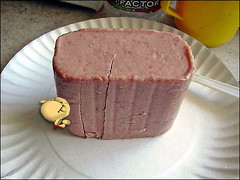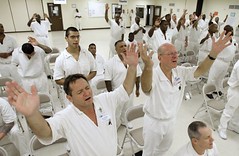Home / Inmates and Prisons

The Chicago Tribune has a three page article about how prison food has evolved the past few years, the theory being, bad food can cause riots and good food makes for good inmates.
Consider the problem: How to provide 2,900 calories a day for $.92 a meal.
Since the American Correctional Association created nutritional guidelines in the 1970s, prisoner meals have adhered to strict dietary standards. Jails and prisons have their own dietitians counting calories and sodium levels, as do contractors like Aramark, which provides food to facilities across Illinois.
Consider this statistic:
From 1900 to 1995, food sparked more than 40 of the 1,334 prison riots in the United States, including the country's deadliest uprising in 1971, when 43 people died at New York's Attica prison, said Gordon A. Crews, co-author of "A History of Correctional Violence."
More...
(7 comments, 461 words in story) There's More :: Permalink :: Comments
Prison Nation sets another record:
About one in every 31 adults in the United States was in prison, in jail or on supervised release at the end of last year, the Department of Justice reported yesterday. An estimated 2.38 million people were incarcerated in state and federal facilities, an increase of 2.8 percent over 2005, while a record 5 million people were on parole or probation, an increase of 1.8 percent.
The racial disparity that TalkLeft highlighted in this story is confirmed by the statistics:
In several states, incarceration rates for blacks were more than 10 times the rate of whites. In Iowa, for example, blacks were imprisoned at 13.6 times the rate of whites, according to an analysis of the data by the Sentencing Project, a research and advocacy group.
(6 comments) Permalink :: Comments

Via Crooks and Liars, the 8th Circuit has struck down public funding for faith-based prisons.
The opinion is here (pdf.)
In the present case, plaintiffs demonstrated (and defendants do not seriously contest) that the InnerChange program resulted in inmate enrollment in a program dominated by Bible study, Christian classes, religious revivals, and church services.
The DOC also provided less tangible aid to the InnerChange program. Participants were housed in living quarters that had, in previous years, been used as an “honor unit,” and which afforded residents greater privacy than the typical cell. Among other benefits, participants were allowed more visits from family members and had greater
access to computers.
More...
(31 comments, 500 words in story) There's More :: Permalink :: Comments

Among those on the front lines fighting the California fires this week were prison inmates.
About a quarter of the 14,000 firefighters defending homes and businesses in Southern California from wildfires have been prisoners, officials said. Of the 4,400 inmates trained to battle fires in the state, 3,091 were on the front lines Friday from Lake Arrowhead south to San Diego.
The inmates are paid $1.00 an hour. They also get a day of extra good time for every day spent fighting fires. The savings to California: $80 million a year.
(2 comments) Permalink :: Comments
Connecticut's prisons are a tinder box, overflowed to the point where disaster is sure to strike.
The problem is exacerbated because the Governor, in response to a gruesome killing by two parolees this summer, ordered parole suspended for violent offenders, a class that includes home burglars.
Cubicles built for four are crammed with eight inmates, and enclosed areas known as dollhouses where inmates once played cards and wrote letters now hold 14 bunk beds. The corridors are lined with more beds. Each large room at the Willard-Cybulski Correctional Institution once had 50 beds and now has 118.
A member of the prison guards' union says:
(4 comments, 297 words in story) There's More :: Permalink :: Comments
Time Magazine examines the Florida prison system, particularly in the wake of the acquittal of 13 juvenile boot camp guards last week.
In another Florida case, a 36 year old was stomped to death by guards in his cell. The guards were acquitted despite their boot prints being found all over the inmate's back.
Both verdicts were vivid reminders of what critics call the rot of Florida's corrections culture...While no one is asking Florida to coddle its prisoners, adult or juvenile, many fear it has yet to break its dark habit of coddling abusive guards and other officials watching over those prisoners.
Below are some examples of the prisoner abuses that have come to light through filed lawsuits:
(6 comments, 387 words in story) There's More :: Permalink :: Comments

The show not to miss tonight is Ted Koppel's special on the Discovery Channel: Inside Our Prisons on the broken prison system in California. (9PM ET)
While shooting, Koppel spent a number of days among the general population at Solano. His reporting focuses on the inhabitants of H Dorm, where inmates are stacked in triple-deck bunk beds on an old indoor basketball court. Correctional officers are so badly outnumbered that prison officials keep inmates segregated by race and gang affiliation in a desperate effort to avoid friction and maintain control. Even so, Solano still sees three to four race riots a year. Using smuggled cell phones, gang bosses continue running criminal operations on the street from behind prison walls. At the same time, they’re running drug and prostitution rings inside Solano.
If California doesn't come up with a long-term solution, the federal courts likely will begin ordering the release of prisoners.
It costs as much to house a prisoner in California for a year as it does to send a kid to Harvard. The U.S. incarcerates more people than any other country.
The two hour show is about California, but the same problems exist across the country.
America, Prison Nation.
(12 comments) Permalink :: Comments
With all the candidates focused on Iowa, now would be a good time for Iowans to ask them what they plan on doing to reduce the racial disparity in prison sentences for blacks and whites when it comes to drug crimes.
It's an issue that affects them directly.
The number of blacks behind bars for drug-related crimes is rising again in Iowa. At the same time, a new anti-methamphetamine law has resulted in fewer new prison admissions for white Iowans.
Officials in drug, corrections and law enforcement circles say it's not yet clear why more blacks are being sent to prison, but the impact is clear: The state's notorious disproportion of blacks behind bars vs. whites is growing again.
How bad is it in Iowa?
Emotions on the issue flared anew this July when the Sentencing Project released its study showing the rate of black incarceration in Iowa was six times that of whites. Feeding that disparity, researchers said, was that blacks make up just 2.3 percent of Iowa's 2.98 million residents.
...Those who defend and advocate for the disadvantaged argue that state leaders have done almost nothing to address the biases in the justice system that contribute to Iowa's notoriety.
The problem also exists at the federal level. It's time the candidates were called on to address it.
(17 comments) Permalink :: Comments

Via Sentencing Law and Policy, the Senate's Joint Economic Committee (JEC) will hold a hearing this morning on ""Mass Incarceration in the United States: At What Cost?" The purpose is "to explore the economic consequences and causes of and solutions to the steep increase of the U.S. prison population."
The press release is here (pdf).
The United States has experienced a sharp increase in its prison population in the past thirty years. From the 1920s to the mid-1970s, the incarceration rate in the United States remained steady at approximately 110 prisoners per 100,000 people. Today, the incarceration rate is 737 inmates per 100,000 residents, comprising 2.1 million persons in federal, state, and local prisons. The United States has 5 percent of the world’s population but now has 25 percent of its prisoners. There are approximately 5 million Americans under the supervision of the correctional system, including parole, probation, and other community supervision sanctions.
More...
(16 comments, 303 words in story) There's More :: Permalink :: Comments
Prison Nation continues to grow.
The number of inmates in adult correctional facilities in the United States has topped two million for the first time, the Census Bureau said yesterday.
It isn't exactly cheery news that there are more people residing in prison than in nursing homes, or that there are slightly fewer living in prison than in college dormitories. The most shocking comparison is this one:
Among people living in group quarters, whites were almost twice as likely to be living in a dormitory than a prison, while Asians were nine times more likely to be in a college dorm than in prison. But blacks and Hispanics were about three times as likely to be imprisoned than to be living in a dormitory.
(19 comments) Permalink :: Comments
The Bureau of Prisons has never been responsive to groups that advocate for prisoners' rights, but it turns out that BOP listens to Republicans and evangelical talk show hosts. The Bureau reversed its decision (reported here) to purge prison chapel libraries of all religious texts that aren't on a government-approved list. The new plan seems to be a selective purge.
In an e-mail message Wednesday, the bureau said: “In response to concerns expressed by members of several religious communities, the Bureau of Prisons has decided to alter its planned course of action with respect to the Chapel Library Project. The bureau will begin immediately to return to chapel libraries materials that were removed in June 2007, with the exception of any publications that have been found to be inappropriate, such as material that could be radicalizing or incite violence. The review of all materials in chapel libraries will be completed by the end of January 2008.”
What standards will govern the determination that a religious text is "inappropriate"? Will those decisions be free from religious bias? Don't expect BOP to answer those questions.
more...
(3 comments, 267 words in story) There's More :: Permalink :: Comments
Leave it to the Bureau of Prisons to find a way to unite the religious right and the civil liberties loving left. Despite protests from religious groups, Congress, and defenders of the Constitution, the BOP has refused to overturn its policy of purging religious texts from prison libraries. Only those texts deemed "appropriate" by federal bureaucrats are available for inmates to read.
Outrage over the bureau’s decision has come from both conservatives and liberals, who say it is inappropriate to limit inmates to a religious reading list determined by the government.
If the First Amendment prohibits the government from estabishing a religion, it surely prohibits the government from establishing an approved set of religious texts.
(19 comments) Permalink :: Comments
| << Previous 12 | Next 12 >> |







